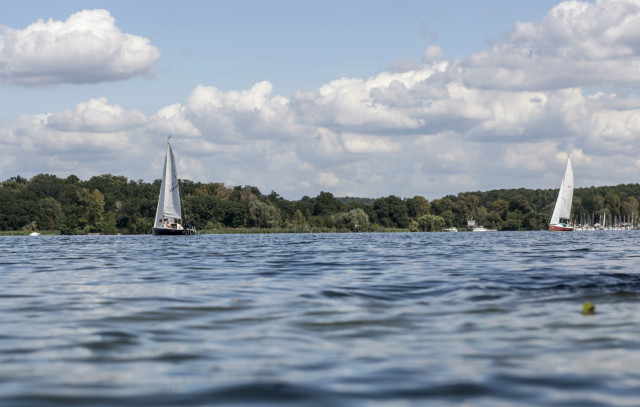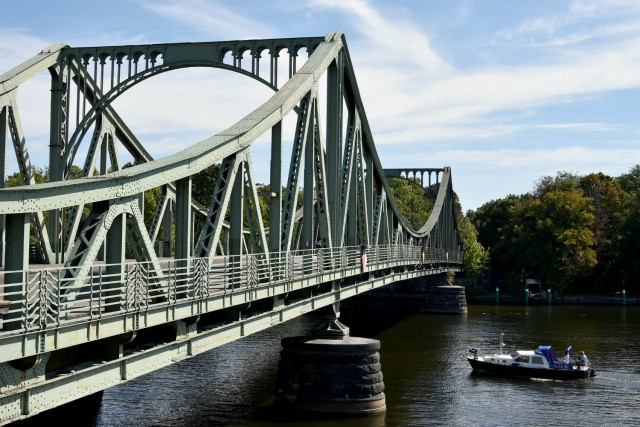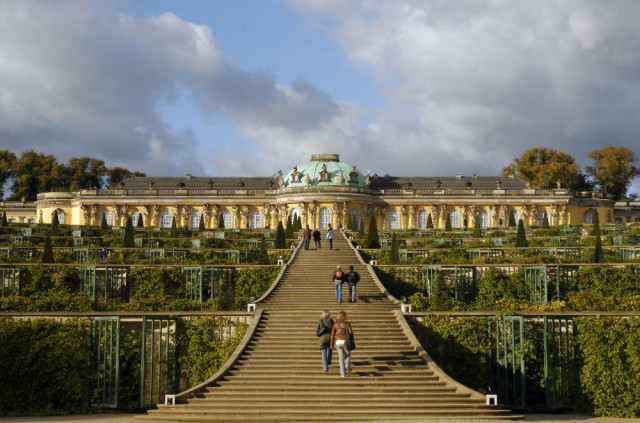Weekend Wanderlust: Hiking to the heart of Potsdam

With dreamy pastel colours, grand architecture and sweeping nature scenes, entering Potsdam and its largest district Babelsberg, feels a bit like escaping into another world, especially if you’ve come from industrial-style Berlin. We explored this gorgeous corner of Brandenburg.
As a Scot, I’m used to being in a landscape filled with hills of all shapes and sizes, even in cities. But it’s not something I come across so often in Berlin’s flat plains.
This is, of course, great for cycling. But I was secretly quite pleased to find that just outside the capital, there are a few more slopes on the horizon.
I was heading to Potsdam, the capital of Brandenburg state and in former times part of East Germany, when I spotted the stunning picturesque forests bursting with green trees. I also noticed a few high points here and there, featuring flashes of sparkling water down below.
Although it’s easy to get to Potsdam by train (from central Berlin it’s around a 40-minute ride), I was opting to hike to this town, known for its grand fairy tale castles and baroque-style buildings.
We met at Wannsee S-Bahn station, on the outer edge of Berlin, on a Sunday morning on a cold yet sunny and clear day. I was taking part in a group hike organized by the North Face called Never Stop Berlin. The group offers walks and other fitness events regularly round the city, and many of them are free to take part in.
SEE ALSO: 10 fascinating things to see in Potsdam
Along with the experienced hikers who walked with sticks, my friends and I set off with homemade rolls (brötchen), chocolate for when our energy dropped and lots of water.
The hike to Brandenburg
It’s easy to see why the lake Wannsee – it’s actually made up of two lakes, Großer Wannsee and the Kleiner Wannsee which come from the Havel river – has become such a destination for city-goers through the years. With lush water, it’s the ideal spot for sailing or taking a dip.
Yet Wannsee also has a darker side. The notorious ‘Haus der Wannsee Konferenz’ (House of the Wannsee Conference), where the Nazi party met to discuss the so-called ‘final solution’ that led to the mass murder of Jews, is situated here.
The building has been a Holocaust memorial and education facility since the early 1990s. After visiting this horror site, the calm atmosphere of the Wannsee allows you to contemplate what happened within those four walls, and of the Nazi’s atrocities.
On our hike we weren’t visiting this memorial situated across the water from the Strandbad Wannsee (the main beach area). We were walking through the Düppeler Forst (forest) and onto Brandenburg’s capital, Potsdam.
After walking past the yachts bobbing happily on the water below, we entered the forest which felt like a secret getaway.
 The Wannsee lake surrounding by forest. Photo: DPA
The Wannsee lake surrounding by forest. Photo: DPA
A serene Sunday getaway
Although it’s not that far from civilization, it felt like we were deep in natural surroundings, days away from any roads. Kicking up leaves and soaking up the fresh air felt like the perfect start to Sunday.
Deep in the forest, civilization crept up on us again, as a series of old-style wooden German buildings came into vision.
We stopped at this spot, which I discovered later was called ‘Nikolskoe’. I found that the views here across the lake were magnificent.
Next we hiked on, facing some climbing activity (which was great for the legs) through the second part of the forest and down to the Klein Glienicke park.
When hiking or cycling around here you’ll be able to spot the Glienicke Bridge, which connects Berlin with Potsdam.
It’s famous because it was once used to exchange captured spies between the Americans and Soviets during the Cold War. You might also recognize the bridge from the 2015 film with Tom Hanks, Bridge of Spies.
 The Glienecke Bridge. Photo: DPA
The Glienecke Bridge. Photo: DPA
Out of the forest, into a palace
We then travelled onward by foot and caught sight of the amazing Babelsberg Palace. There were a few tourists also checking out the site, which looked like something from a fairy tale.
It was the summer residence of Prince William, later German Emperor William I and King of Prussia, and his wife Augusta for over 50 years so it's thoroughly grand.
For me though, the best part of Babelsberg, which is the largest district of Potsdam, is the park surrounding the palace.
It was the moment we caught sight of the sparkling water that made me feel like I was on holiday. The sun shone as the gentle waves lapped onto the shore.
We rested our legs and ate our picnic by the water before making our way to the centre of Potsdam, which is a short walk away.
This hike takes several hours but you can easily split it up or focus on specific areas.
Tracing Prussia's past in Potsdam
Potsdam, which is just 25km from Berlin, is a Prussian paradise, with amazing royal gardens and palaces, which earned themselves Unesco World Heritage status in 1990.
I’ve visited Potsdam a few times but in the summer, during a trip with my mum, I found it really stood out.
We headed straight for Frederick the Great's famous summer palace, Schloss Sanssouci but took in the grand architecture of the city before arriving at the sprawling royal grounds.
Designed by a man called Georg Wenzeslaus von Knobelsdorff in 1747, the palace is over-the-top and indulgent – exactly what you’d expect from any royal with a lot of money.
It attracts lots of tourists especially at peak times of the year. What I found most charming was the park – as you might be able to tell, I love being outdoors. We settled on a bench and inspected grand baths that were placed around the gardens.
The design of Sanssouci was reportedly dreamt up by Frederick the Great as a place where he could be ‘sans souci’ (without any cares). His grave is near to the site.
Frederick's great-great nephew, King Friedrich Wilhelm IV, who inherited the site, added a few more palaces and buildings, which are said to reflect his intense love for all things Italian.
The Neues Palais and the Schloss are spaced out so you can spend a long time wandering around. In fact, we got sore legs checking it all out.
 Sanssouci Palace park vine terraces
Sanssouci Palace park vine terraces
From past to present in Potsdam
After a chill, we headed back to the centre of Potsdam where we spotted the Dutch quarter, with its stand-out red brick buildings which were built in the 18th century for Dutch immigrants.
It's not the only part of Potsdam paying homage to immigrants there: Alexandrowka, a 19th century Russian colony where a few descents still live today in the dachas (summer-style houses). There's also an impressive museum and restaurant with Russian specialties, from borscht to pelmeni dumplings.
We also enjoyed the boutiques and restaurants, as well as looking out at Potsdam harbour. The old market square known as ‘alter Markt’, along with the City Palace, St. Nicholas Church, which has a huge dome, and the Old Town Hall are also quite spectacular.
We didn’t have time to see all of Potsdam’s sights, but I’ll be heading back to tick some more spots off my list, including the Film Museum and to check out what else this corner of Brandenburg has to offer.
Whether it's natural surroundings or its historical architecture, Potsdam is a gem that's bursting with history and is a joy to explore.
Comments
See Also
As a Scot, I’m used to being in a landscape filled with hills of all shapes and sizes, even in cities. But it’s not something I come across so often in Berlin’s flat plains.
This is, of course, great for cycling. But I was secretly quite pleased to find that just outside the capital, there are a few more slopes on the horizon.
I was heading to Potsdam, the capital of Brandenburg state and in former times part of East Germany, when I spotted the stunning picturesque forests bursting with green trees. I also noticed a few high points here and there, featuring flashes of sparkling water down below.
Although it’s easy to get to Potsdam by train (from central Berlin it’s around a 40-minute ride), I was opting to hike to this town, known for its grand fairy tale castles and baroque-style buildings.
We met at Wannsee S-Bahn station, on the outer edge of Berlin, on a Sunday morning on a cold yet sunny and clear day. I was taking part in a group hike organized by the North Face called Never Stop Berlin. The group offers walks and other fitness events regularly round the city, and many of them are free to take part in.
SEE ALSO: 10 fascinating things to see in Potsdam
Along with the experienced hikers who walked with sticks, my friends and I set off with homemade rolls (brötchen), chocolate for when our energy dropped and lots of water.
The hike to Brandenburg
It’s easy to see why the lake Wannsee – it’s actually made up of two lakes, Großer Wannsee and the Kleiner Wannsee which come from the Havel river – has become such a destination for city-goers through the years. With lush water, it’s the ideal spot for sailing or taking a dip.
Yet Wannsee also has a darker side. The notorious ‘Haus der Wannsee Konferenz’ (House of the Wannsee Conference), where the Nazi party met to discuss the so-called ‘final solution’ that led to the mass murder of Jews, is situated here.
The building has been a Holocaust memorial and education facility since the early 1990s. After visiting this horror site, the calm atmosphere of the Wannsee allows you to contemplate what happened within those four walls, and of the Nazi’s atrocities.
On our hike we weren’t visiting this memorial situated across the water from the Strandbad Wannsee (the main beach area). We were walking through the Düppeler Forst (forest) and onto Brandenburg’s capital, Potsdam.
After walking past the yachts bobbing happily on the water below, we entered the forest which felt like a secret getaway.
 The Wannsee lake surrounding by forest. Photo: DPA
The Wannsee lake surrounding by forest. Photo: DPA
A serene Sunday getaway
Although it’s not that far from civilization, it felt like we were deep in natural surroundings, days away from any roads. Kicking up leaves and soaking up the fresh air felt like the perfect start to Sunday.
Deep in the forest, civilization crept up on us again, as a series of old-style wooden German buildings came into vision.
We stopped at this spot, which I discovered later was called ‘Nikolskoe’. I found that the views here across the lake were magnificent.
Next we hiked on, facing some climbing activity (which was great for the legs) through the second part of the forest and down to the Klein Glienicke park.
When hiking or cycling around here you’ll be able to spot the Glienicke Bridge, which connects Berlin with Potsdam.
It’s famous because it was once used to exchange captured spies between the Americans and Soviets during the Cold War. You might also recognize the bridge from the 2015 film with Tom Hanks, Bridge of Spies.
 The Glienecke Bridge. Photo: DPA
The Glienecke Bridge. Photo: DPA
Out of the forest, into a palace
We then travelled onward by foot and caught sight of the amazing Babelsberg Palace. There were a few tourists also checking out the site, which looked like something from a fairy tale.
It was the summer residence of Prince William, later German Emperor William I and King of Prussia, and his wife Augusta for over 50 years so it's thoroughly grand.
For me though, the best part of Babelsberg, which is the largest district of Potsdam, is the park surrounding the palace.
It was the moment we caught sight of the sparkling water that made me feel like I was on holiday. The sun shone as the gentle waves lapped onto the shore.
We rested our legs and ate our picnic by the water before making our way to the centre of Potsdam, which is a short walk away.
This hike takes several hours but you can easily split it up or focus on specific areas.
Tracing Prussia's past in Potsdam
Potsdam, which is just 25km from Berlin, is a Prussian paradise, with amazing royal gardens and palaces, which earned themselves Unesco World Heritage status in 1990.
I’ve visited Potsdam a few times but in the summer, during a trip with my mum, I found it really stood out.
We headed straight for Frederick the Great's famous summer palace, Schloss Sanssouci but took in the grand architecture of the city before arriving at the sprawling royal grounds.
Designed by a man called Georg Wenzeslaus von Knobelsdorff in 1747, the palace is over-the-top and indulgent – exactly what you’d expect from any royal with a lot of money.
It attracts lots of tourists especially at peak times of the year. What I found most charming was the park – as you might be able to tell, I love being outdoors. We settled on a bench and inspected grand baths that were placed around the gardens.
The design of Sanssouci was reportedly dreamt up by Frederick the Great as a place where he could be ‘sans souci’ (without any cares). His grave is near to the site.
Frederick's great-great nephew, King Friedrich Wilhelm IV, who inherited the site, added a few more palaces and buildings, which are said to reflect his intense love for all things Italian.
The Neues Palais and the Schloss are spaced out so you can spend a long time wandering around. In fact, we got sore legs checking it all out.
 Sanssouci Palace park vine terraces
Sanssouci Palace park vine terraces
From past to present in Potsdam
After a chill, we headed back to the centre of Potsdam where we spotted the Dutch quarter, with its stand-out red brick buildings which were built in the 18th century for Dutch immigrants.
It's not the only part of Potsdam paying homage to immigrants there: Alexandrowka, a 19th century Russian colony where a few descents still live today in the dachas (summer-style houses). There's also an impressive museum and restaurant with Russian specialties, from borscht to pelmeni dumplings.
We also enjoyed the boutiques and restaurants, as well as looking out at Potsdam harbour. The old market square known as ‘alter Markt’, along with the City Palace, St. Nicholas Church, which has a huge dome, and the Old Town Hall are also quite spectacular.
We didn’t have time to see all of Potsdam’s sights, but I’ll be heading back to tick some more spots off my list, including the Film Museum and to check out what else this corner of Brandenburg has to offer.
Whether it's natural surroundings or its historical architecture, Potsdam is a gem that's bursting with history and is a joy to explore.
Join the conversation in our comments section below. Share your own views and experience and if you have a question or suggestion for our journalists then email us at [email protected].
Please keep comments civil, constructive and on topic – and make sure to read our terms of use before getting involved.
Please log in here to leave a comment.